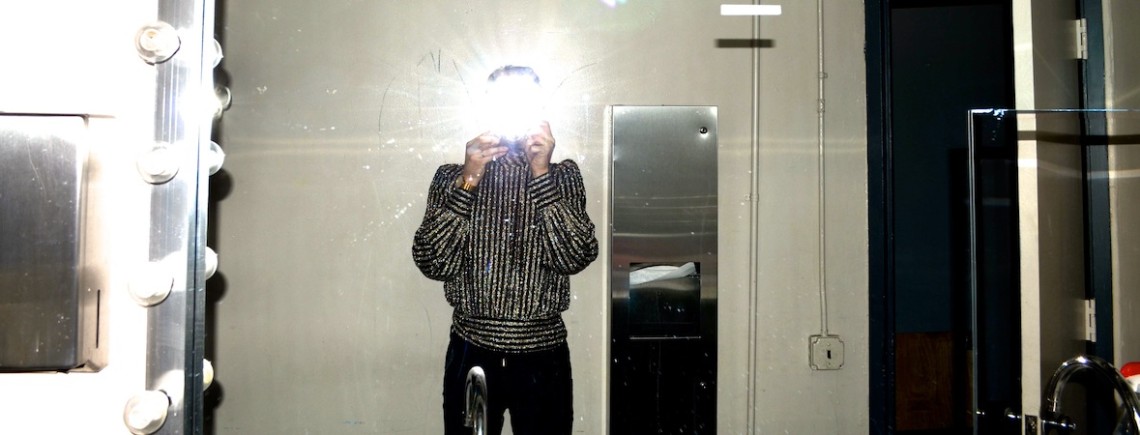Archives

2 Days of Not So American Realness
2 Days of Not So American Realness
by Marissa Perel
published on: January 17, 2013
Saturday, January 10, 5:30 PM
Dana Michel squirms, pants, gathers herself up under a black hoodie and baggy pants, adrift in a listless stupor. But this listlessness is focused, she seeks to destabilize the atmosphere to test our attention, and our capacity for sitting with the uncanny. There is nothing recognizable about her speech or movement, she avoids eye contact at all costs, yet there is something familiar about this troubling feeling, this sadness, this eerie summoning of racial tropes.
White, antiseptic set, white cotton swabs strewn around her body, mushed creaminess of masticated banana bulging from her lips, a painted yellow trumpet, the sounds of which become a continuation of her speech in its absent sputtering – these objects, taken up and mis-treated in their own time, accumulate to form a landscape of dis-use. Michel’s body is at once a part of this landscape and is the catalyst for it, pouring kool aid into a silver bowl, stretching out time as she slowly consumes the liquid, head bent over a table, appearing to nod off and then returning to sip it. The alchemical kool aid works its way through her body as she begins to recite a recipe for seasoned breadcumbs and a hair treatment. But the recipe is undone by the repetition, breaking, and slurring of her speech. Michel’s language, like her objects, exist outside of signification, outside of time and space. It is the utterance in its barest sense, wavering on the cusp of meaning and nothingness.
We hear a thudding bass. Her body gyrates on a chair with stockinged feet, we all know this bouncing: legs spread, knees bent, ass hitting the floor.
On her chair, now, Michel raises a platinum blonde wig as a gospel song resounds in the stark white space. She stabs at it with ambivalence, resentment, riding on the edge of real violence, though she never falls into that kind of acting out. The blonde wig is a joke, but the feelings for, of and about what it represents are not funny. Internalized oppression spreads like a contemptuous, thickening fog throughout the theater.
Then there’s a working backward into concealment, putting on the black hoodie again, and the backpack. Michel walks around the stage, preparing it for more blaring absurdities of cultural politics. She attempts to tell the weather on a piece of brown paper with a black marker, again the language isn’t the point. It’s the spectacle of speech, and the feeling of that spectacle.
She goes off the edge of the paper and marks a white curtain with the marker, a fatal blemish to her set. She then improvises an apology to the audience, the staff, but it comes out like the rest of her piece, and we break down from its suspended hilarity.
She takes a hand, puts it in a jar of fluff, nearing the end of the show. The white, artificially sweetened goo stuck on her black hand, stuck to her pants, a glue that will never cease to adhere.
* * *
Sunday, January 11, written over the course of 3 hours watching Mårten Spångberg’s La Substance, but in English
What is selfhood? Is the self a consumerist idea? What kind of information is in a gesture? Is the performative v. the everyday still a distinction worth making? The quotidian has, by now, been quite subsumed into contemporary consciousness. So what is the body for, anyway? This concept of the body’s Modernist potential for greatness becomes less seductive than intentional or unintentional moments of the sublime, which is really just a conflation of our escape fantasies. That moment when identity is no longer chained to things – that fabulous loss of gravity and time. Floatingness, is that not today’s desired product? The promise of escape as ultimate experience.
Being a clown or being a sad clown or an ugly clown or a half undone clown, the willingness to confront your own frayed expectations of your identity to reveal a self undone. You are floating between what you think you are, and what you simply don’t know that you are because on the other side of the sublime is the void. The void isn’t ever what we want to see. The void itself is a confrontation, untoward – it is the space of possibility and thus fear. What if Realness is the courage to occupy this space, and reflect it to the audience without fear?
Realness is coercive, Realness is conflicted, and therefore Realness is both multiple and elusive. Our illusions get unearthed and through this our desires and assumptions about our desires get exhumed. Contemporary art is hard just like being in a body. I don’t think I’ve articulated our cultural underbelly quite enough yet. What I mean to say is that sexuality and race, taste and value, are the product of unexamined cultural assumptions. When these assumptions are examined, it’s like the fire alarm the in the theater or museum or other such institution has gone off, you get that fight or flight feeling, maybe you cough or laugh because you can’t run away. But if the sprinkler system went off and covered you with water, you’d probably be relieved, but then everyone would see through your clothes and maybe that transparency wouldn’t be such a relief after all.
So it’s much better to stay here and uncover your own fear and shame or whatever you’re hiding by being present with and available to the performance in front of you. We create epic mythologies about what can happen in time and space, creating the show in our minds before we give ourselves a chance to acknowledge what exists there. Where do you find the art in all your projections? Is it what you’ve mythologized? Is it what you see, clear of internal monologue? Maybe it exists somewhere between those modes of desire and perception. Stepping into the void, we learn about it a little more and we come understand why we are here right now. We come to terms with what we can fulfill for ourselves and what we can never possibly figure out how to satiate.
Identity as a skin, worn away, performance as the activity of shedding, unraveling and exposing of a new, raw membrane. You sit waiting for something. The extravagant emotional rollercoaster of waiting is the map of your internal topology that expands to meet the terrain before you. Yes, you are working in this waiting. We are all here to work. We are not sitting passive while our shadow selves are benignly served up in delicate portions. We are working on these selves and even working on these non-selves and we are becoming the other that we see.
image: Ian Douglas
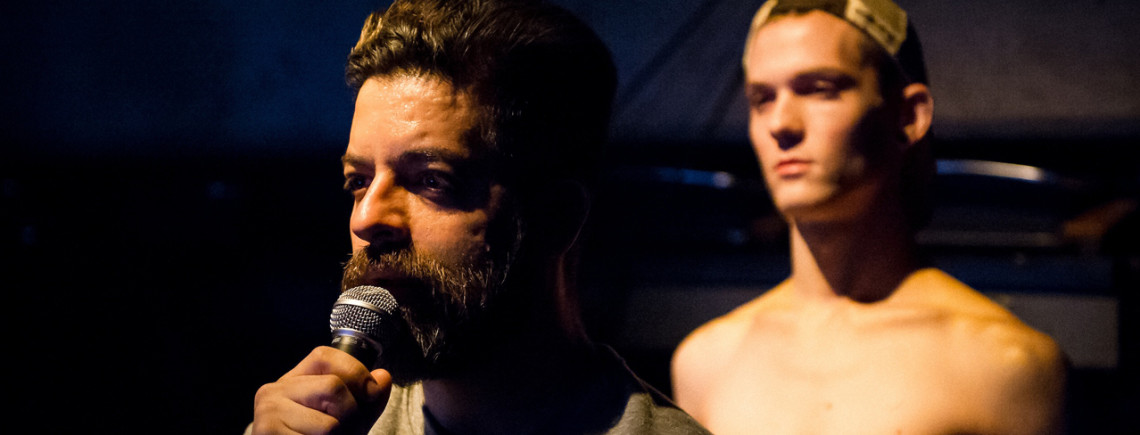
300 Words on Realness: myendlesslove
300 Words on Realness: myendlesslove
by Lydia Mokdessi
Published on: January 17, 2014
Meditating on the poetics of gay sex, Miguel Gutierrez’s myendlesslove is a mysterious dance; it is honest but nostalgic, funny, and deeply sad. Dressed in briefs and high-heeled boots, Gutierrez surveys us serenely as we enter. He chats with a VHS tape version of himself on a TV screen as if giving a pre-show interview (“what are you going to show us today?” “whatever happens.”) that turns flirtatious (“I hope you try all the possible positions.” “I’m hot to find out.”). The other screens flicker on to show Gutierrez, thrusting and making eyes, a cuddly fantasy date between two young men, and just the faces of four others.
Cigarette in one hand and harmonica in the other, he watches himself in a mirror held by collaborator / object-of-desire Connor Voss before building a solo vocal track (“loveyouloveyouLOVEYOUloveyou”) with a looping pedal. It starts off sweet and meek, accumulates to multilayered many-part harmony, and abruptly turns silly (“I went online last night, I didn’t meet anyone nice. No one wants to know that shit.”). He strips down and whips around wildly like a club dancer, changing gears to swap the bass-heavy electronic music for his own acoustic rendition.
Pulling Voss by the waistband, they slither along the floor and walls, mouth to groin. There’s power in Voss’ detachment — Gutierrez is the vulnerable character now. He has been performing wildness but we suddenly wonder if there’s been something shaky about him from the beginning. Maybe it’s impossible for him to deliver what he thinks is required.
The melancholiness of the scene is offset by porn playing loudly on another screen. Gutierrez sings drunkenly, held up by Voss, before being lowered to the floor for a brief and clumsy duet. It’s haunting to watch the previously cocky / seductive Gutierrez lose control of what he’s made — his dissolution gets at a slipperiness between desiring someone and desiring something to make you forget about what makes you sad. The shiny exterior is brittle and the inside is dark; we are not immune to the complex politics / self-delusions of sex and love, even when we’ve been warned.
image:Ian Douglas
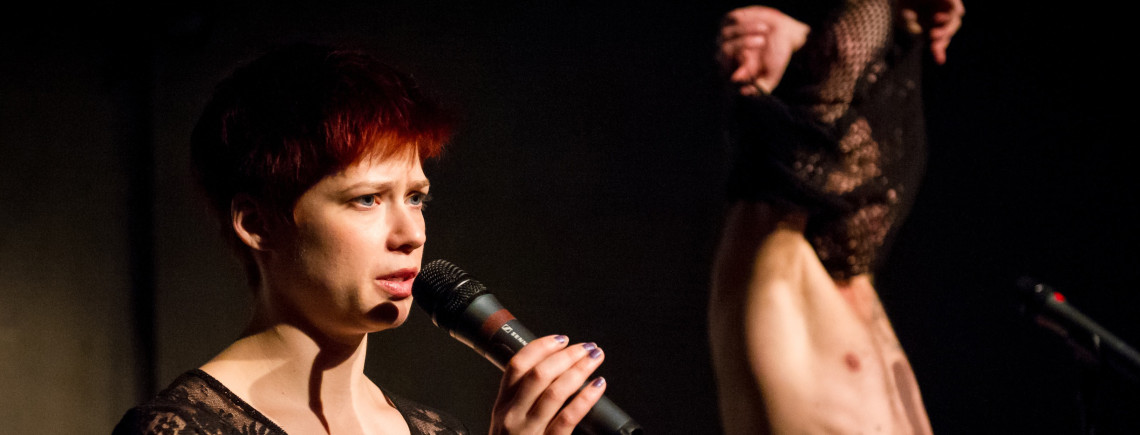
A Seemingly Perverse Dynamic: Transgressive art and Contemporary Performance
A Seemingly Perverse Dynamic: Transgressive art and Contemporary Performance
by Jeremy Barker
Published on: January 17, 2014
This is a moment I won’t easily forget in the theatre: [Annie] Sprinkle’s smiling face and robust, cooing voice, her very white and soft body largely exposed, encouraging a spectator to scrutinize and describe her labia. I shrink back from the spectacle in my seat, filled with rage at [Richard] Schechner, who is submitting me and other women to this assault on our bodies via this alien medium, this . . . who is she? Is she a woman like me? Does she smile because she enjoys this or smile because she is encoded by pornography to convince men she “enjoys” this? The act becomes more threatening still when Sprinkle offers to “give a little demonstration of cock sucking.” By now blind to objective critical judgment, whatever that might be in such a case, I feel violated and furious at my entrapment here.—Elinor Fuchs, “Staging the Obscene Body,” TDR, 1989
Any discussion of contemporary art that asserts it is or is framed as transgressive or obscene is problematized by the fact that, often, art that include obscenity of transgressive acts doesn’t actually seem obscene or transgressive in the anything-goes world of contemporary art. When I tell someone that there’s an artist I really like who, in one of her performances, invites audience members onstage to help humiliate her, one of whom is a plant she hired off Craigslist to masturbate over her before she gives him a blowjob, and then does a head stand with a lit candle inserted in her vagina, well, actually in my world, I’m likely to get told, “Well, that’s sort of passé.”
It’s been a long time since Stravinsky and Diaghalev could incite the masses to riot through the shock of the new, the sort of event that’s long since been exaggerated from scandalous fact to outright mythology. The old avant-garde imperative épater la bourgeoisie has gone from de rigueur for contemporary artists to the tedious practice of college students who still imagine nudity and sex (usually) or more scatological material that will piss off the folks back in the ‘burbs makes for good art. Unfortunately, the folks back in the ‘burbs aren’t likely to care very much about what artists do unless conservatives want to make a culture war redux fuss over some exhibition, meaning that the artist who attempts to transgress is doing so only in in their own imagination.
The thing we miss though—and that I’ve often been at pains to explain when describing the work of Rebecca Patek—is that its shock value lies in the much subtler nuances of contemporary performance itself. It aims—and succeeds enough for her to warrant serious attention—at challenging the art world audiences that do show up, attacking not the staid and often hypocritical values of mainstream American culture but rather the pretensions, hypocrisy, and ridiculousness of the very milieu in which she operates.
In researching this piece, I came across an essay from 1989 by long-time Village Voice critic Elinor Fuchs, quoted above. What struck me as fascinating about it is that Fuchs doesn’t rely on the false objectivity critics usually adopt when addressing the “controversial,” “transgressive,” “pornographic,” or “obscene.” Instead, Fuchs provides an insightful personal account of a decade’s worth of performances by female artists that challenged her, a knowledgeable critic embedded in the downtown arts scene. Her idiosyncratic account is an important record of the tensions in the aesthetic and political discourse of the period that informed the work artists were producing.
She locates the essential conflict as one emerging within feminist discourse itself, centered primarily on pornography or, more broadly, representation of female sexuality. For some emerging from the 1970s, pornography was just one more form of sexist violence against women that could be done away with. For others, primarily (though not exclusively) in the younger generation of artists and thinkers, this absolutist view missed the point: the issue wasn’t the medium, it was who controlled it. Banning obscenity (however one came to define it) did fairly little for the cause of liberation. For these artists, obscenity could serve the purpose of allowing them to reclaim their bodies, sexuality, and experience.
Starting with a fairly anodyne description of a scene in a Joanne Akalaitis play the rehashed a sexist comedy routine and caused a kerfuffle in an anti-nuclear arms protest, Fuchs goes on to describe works by Kathy Acker with Richard Foreman, the Wooster Group and their homemade porno film, Annie Sprinkles with Richard Schechner, and so on, tracing her complex and evolving responses to artists who incorporated material that, in other circumstances (and perhaps even in context) would be exploitative.
It goes without saying that those who favored the incorporation of obscenity in art largely won the day, with resistance as ineffective as anti-porn legislation efforts, all of which set the stage for the culture wars that exploded in the Nineties. Today, the sort of material Fuchs expresses such ambivalence about is incorporated by the larger art world with precious little fuss, and the shock-value of these tactics has since become cliché.
But what has this all accomplished politically? The answer would appear to be, “Not much.” Sure, women have the ability to incorporate sex acts into their artistic work with downtown audiences barely batting an eye, but has the power structure changed? The three largest festivals downtown in January—PS 122’s COIL, Under the Radar, and American Realness, in which Patek herself is programmed—are controlled by men. All the ready embrace of feminist art hasn’t affected the increasingly sophisticated marketing machine, which promotional materials for virtually every major institution and festival (particularly those presenting dance) using picture of lithe young female dancers. The realm of what’s acceptable material in performance may have been dramatically expanded, but the underlying power structure—the critics, the programmers and curators, the funding bodies—remain largely controlled by men. Usually white, and often straight.
And this is why Fuchs’s essay, I think, is in so many ways important: It documents artists challenging not the paper tiger of the faceless mainstream masses, but in fact the biases, opinions, and assumptions of the artistic world itself. It’s in this vein where Patek and a small group of others are operating, and where the primary importance of their work lies.
In a 2005 essay on Franklin Furnace (“The Fiery Furnace: Performance in the ‘80s, War in the ‘90s”), C. Carr recalls a 1985 piece by Dancenoise, Made for TV Terrorism. “Dancenoise would soon challenge every bromide laid out to little girls—and then some,” Carr says of the set, a massive, messy installation of childhood bric-a-brac.
They performed surgery on a female dummy, tap-danced, ran full force into a wall, removed two male dummies in long johns and lizard heads from a refrigerator, talked about terrorism, and endured many many fast costume changes. I’m sure that isn’t the half of it. Near the end, they fought each other with knives, then disemboweled the lizard-headed dummies they’d hung from the ceiling during some hardboiled pas de deux, leaving so much fake blood and real slime on the floor they could have skated away. Here was a “critique of representation” that burst right from the gut. Sexton and Iobst never intellectualized about their stuff, but they were among the transgressive women performers of that era who worked straight from the id to address issues of power and control—a fact I was just starting to put together in October 1985. I only knew then that the show thrilled me.
Here we see Dancenoise challenging the dominant paradigm of girlhood and femininity. Their target is media representations and their use to enforce social gender norms, the power structure of inherent in the broader culture and the violence it exercises on women. Reading it, though, I couldn’t help but think of Patek’s Real Eyes, her first evening length presentation by the Chocolate Factory in May 2012. In this piece, too, the artist is directly challenging the power structure which seeks to impose itself on her, but in this case, the villain, such as it is, is Yvonne Rainer.
In the piece, Patek performs sections of Rainer’s own Trio A, a piece she learned in college (the imposition of dominant forms through education, a throughline of feminist critique). Rainer, having heard about the piece at an earlier stage of development, sent Patek a letter protesting the unauthorized use of Rainer’s work. Having “failed” as a dance artist, Patek invites members of the audience to help humiliate her as she tries to dance. One (a real audience member), is brought onstage and paid to tackle her repeatedly. Another (this one a plant, hired off Craigslist), furthers the humiliation by walking on as a flasher, masturbating over Patek’s naked, writhing body until she proceeds to give him head.
Humiliation is one of Patek’s primary themes. I can’t speculate on whether this springs from a personal place or is a simply a device. Humiliation is a core part of humor, and Patek’s work is usually comedic, though she typically employs humor not to satisfy but to disarm the audience, to invite them, through laughter, to arrive an uncomfortable place. Often, the humiliation and absurdity is framed as a failure of herself as a dance artist.
The first piece I saw by Patek was relatively tame, considering. Her short as part of the 2010 Fresh Tracks group at the then-Dance Theater Workshop, was called Jessica’s Story. Patek arrives onstage seemingly nervous and awkward (the hallmarks of her character in performance), and informs the audience that the piece they’re seeing was supposed to be a duet, but her partner pulled out and now she has to do it solo. The subject of her dance, she explains, is an expression of the personal experience of Jessica McClure, the one voice we never heard from during the media firestorm surrounding her, when, as an 18-month old, she fell down a well in 1987.
Patek tells monologues of an increasingly ridiculous nature, expressing her frustration with McClure for refusing to comment publicly on the experience and denying the nation full catharsis. Toward the end, as the audience is led through a call-and-response prayer, Patek stages herself as a Christ-like figure whose suffering can make up for McClure’s denial of closure: Two audience members are invited onstage to soak her with squirtguns.
The piece was funny and inviting but in some ways quite tame. Patek’s intelligence and talent were clear, as was her willingness to challenge the pretensions of choreographers who frame their work as increasingly ridiculous responses to the issues and experience, often delivered in remarkably tone-deaf fashion.
The next piece of hers I saw was a year or so later, at a comedy in dance festival at Triskelion Arts in Brooklyn, a low-key, low-budget affair and, honestly, not the sort of thing I’d usually bother with. But intrigued by Patek’s work, I went to see her perform as part of a mixed bill. Again, she began with a monologue, recounting her (dazed and confused) disillusionment with dance, and how a friend, knowing she likes “multicultural experiences” invited her out to dinner at an Ethiopian restaurant, where, to her shock, she discovered that “Africans are so poor, they can’t afford silverware.”
The piece develops as an extended riff on artists’ naïve and often condescending attempts to be socially engaged. The event we’re watching is not a performance, it’s a fundraiser for her new non-profit relief effort (a donation bucket is passed around), which mostly consists of her intending to buy a bunch of Purell and fly to Africa to hand it out. For the centerpiece performance, she requests an audience member join her onstage (the night I saw it, it was a man though she’s performed it with both genders). The participant puts on latex gloves and is blindfolded onstage, at which point Patek exits for a fairly long period of time. The audience titters, the participant, slightly embarrassed and confused begins awkwardly laughing.
When Patek re-enters she’s dressed as a stripper, in thong and high-heels, and carrying a bottle of hand-sanitizer. She lubes up the participant’s gloved hands with the sanitizer, then proceeds to perform an erotic dance, rubbing up against him to the increasingly hysterical audience until, finally, taking his hand, pushing it inside her thong, and guiding him to masturbate her. The feeling in the room has changed, from surprised, awkward humor to increasing discomfort, with the blindfolded participant, himself obviously surprised and uncomfortable, serving as a cipher for the rest of the audience’s feelings. It goes on for a while, possibly to the point of orgasm, and then, as the coup-de-grace, Patek turns to face the audience in wide-eyed mortified embarrassment, and runs out, leaving the participant standing awkward, smeared with sanitizer (or, likely, lube) alone and unaware of exactly what was happening. It was a remarkable moment.
With inetern(a)nal f/ear, Patek sought to realize a more advanced version of the themes she’s been working in: exposing the shallowness of much art-making, humiliation, body shame, and sexuality. Nominally, the piece is structured as a self-empowerment seminar for survivors of sexual violence. It opens with a short video documentary recounting Patek’s character’s experience as a sexual assault survivor, satirizing the hipster Bushwick art scene at the same time. Then Patek and her co-performer Sam Roeck enter, each with microphones. The first few scenes are interpretive dance sequences to treacly, inspiring music, during which Roeck explains his character’s sexual assault experience.
As a 17-year-old, he found himself having anal sex for the first time with an older man. Experiencing substantial pain, he requested the man stop. Several months later, he discovered he had contracted HIV.
Until this point, inetern(a)nal f/ear functions primarily as a cheeky satire of sexual assault survivor therapy, presenting a mixture of confessional monologues and empowering art acts. But after Roeck finishes his monologue, the piece begins to twist itself into increasingly ambivalent and troubling directions.
Patek takes a seat in the audience and interrogates Roeck as though at a talkback. After praising his courage for speaking out publicly, she begins to question what happened. Did the sex begin consensually? Did the man stop when asked? How loud did Roeck ask? From there, the two stage a series of scenes in which they play out the sort of social and personal doubts of sexual assault survivors. In one sequence, they perform Liz Lerman critical feedback method, taking turns as one another, during which Patek’s character’s own experience is challenged. Since her assailant fled once she wet herself, was it a “real rape”? In another scene, Roeck, breaking character, reads a letter he wrote to Rebecca in which he expresses his belief that by performing in the piece, he himself has suffered emotional distress akin to a rape survivor. As he does this, Patek begins undressing him and fondling him.
It’s during this middle period that the video begins shifting aesthetic quality. What was once anodyne documentary footage gives way to a series of pornographic sequences in which Patek is shown talking about her character’s experience while performing hand-jobs, giving and receiving oral sex, and getting fucked. The porn film extends thematic elements which first crop up in the promotional materials, which feature close-ups of Patek having received a facial cumshot.
The facial is probably the most fraught image in straight porn, suggesting both male domination and empathy (by virtue of meeting the gaze of the other) at the same time. During the filmed sequences, Patek likewise addresses the camera directly, mimicking the POV dynamic porn aims for by creating a link between the fantasizing spectator and the erotic object. The pornographic dynamic comes to dominate our understanding of the piece such that, by the end, in which Patek re-enacts her sexual assault with Roeck fucking her with a strap-on, the audience has been implicated in inetern(a)nal f/ear’s seemingly perverse dynamic: Patek is reclaiming her sexual experience as positive, overcoming the sense of victimization sexual assault can engender, but in doing so she’s implicated the audience by making them spectators in a pornographic performance. She’s basically asking her audience to assent to viewing rape porn as a way of helping overcome rape.
While I do believe that inetern(a)nal f/ear is an essentially positive piece, it’s certainly swimming in dangerous waters. Patek has employed porn—which exists for no other purpose than getting the viewer off—as a way to reclaim a sense of lost agency. By choosing to represent herself and her sexuality using the least subtle aesthetic means possible, she’s leapt straight into the debate of representation of women Fuchs discusses. That she’s employing it as a tactic to deal with the guilt engendered by sexual assault adds a distinctly problematic element to it. Artistically, she’s working in the same area staked out by Ann Liv Young, whose work often functions as a savage critique of the art world’s ability to incorporate feminist critique into its own market dynamics, defanging artists in the process. Like Ann Liv, Patek’s art works as much in spite of its audience as because of it.
image: Ian Douglas
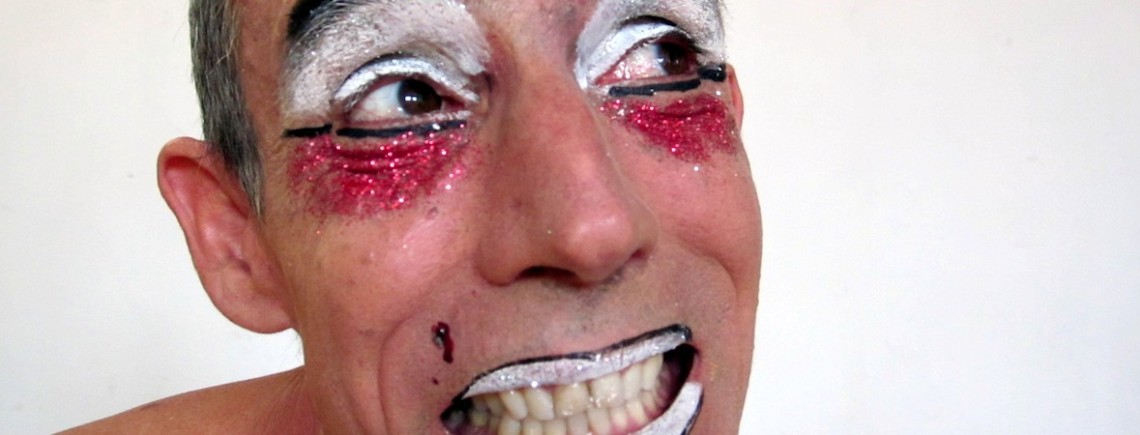
Lucy Sexton, Anne Iobst & Scott Heron
PRODIGAL HEROES
An Evening of Legendary New Work

Eleanor Bauer
Bauer Hour

Eleanor Bauer
Midday and Eternity (The Time Piece)
US Premiere
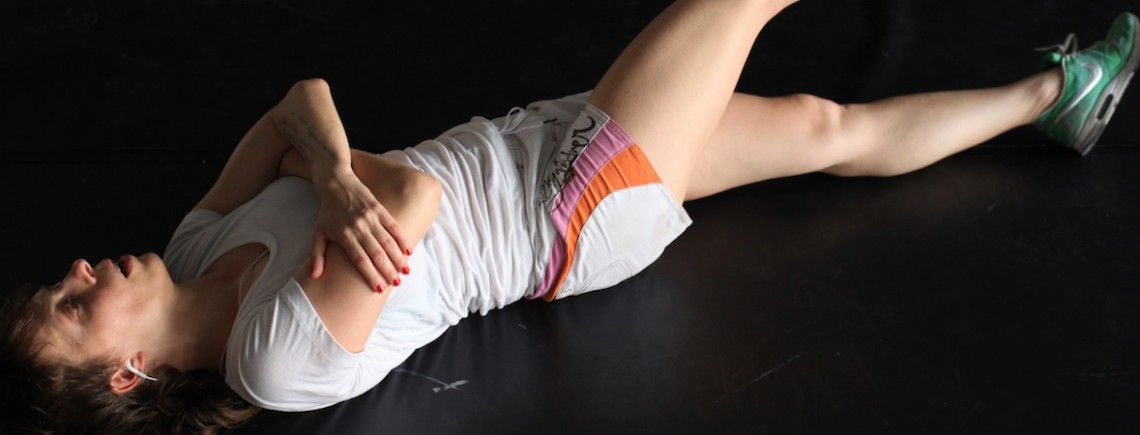
Eszter Salamon
Dance for Nothing
US Premiere

Rebecca Patek
inter(a)nal f/ear
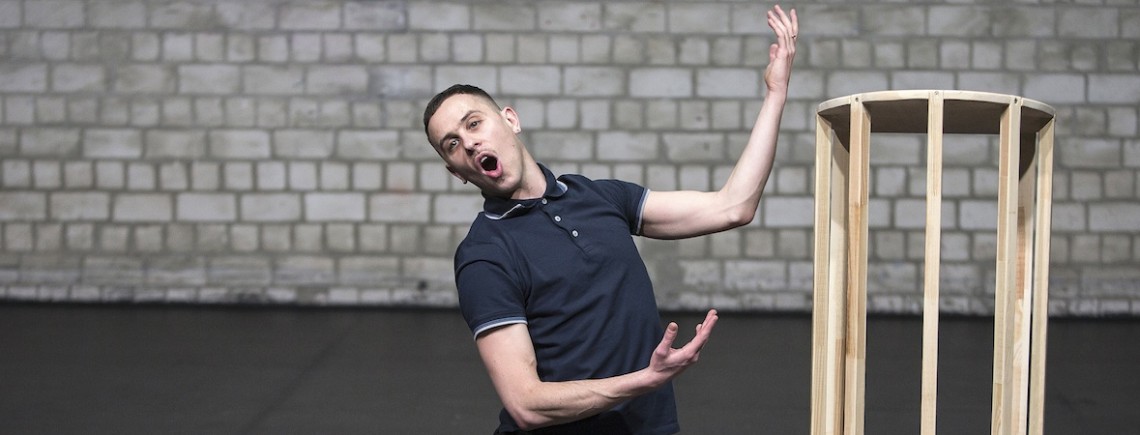
Adam Linder
Cult to the Built on What
New York Premiere

